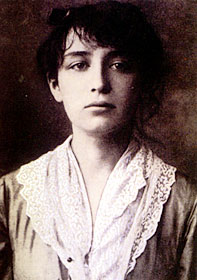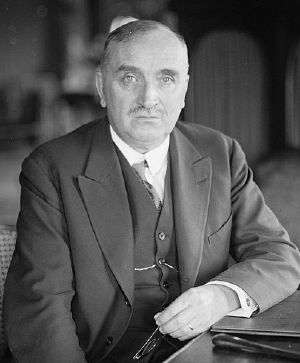Difference between revisions of "Camille Claudel" - New World Encyclopedia
m |
m (→Legacy) |
||
| Line 38: | Line 38: | ||
==Legacy== | ==Legacy== | ||
| − | [[Image:The Kiss.jpg|thumb|left| | + | [[Image:The Kiss.jpg|thumb|left|150px|''The Kiss'' showing the passion of love experienced by Camille Claudel]] |
Though she destroyed much of her art work, about 90 statues, sketches and drawings survive. | Though she destroyed much of her art work, about 90 statues, sketches and drawings survive. | ||
Revision as of 23:47, 10 October 2008
Camille Claudel (December 8, 1864 – October 19, 1943) was a French sculptor and graphic artist who showed promise at a young age. She was the older sister of the French poet and diplomat, Paul Claudel. She was the student of Alfred Boucher and then Auguste Rodin with whom she had a tumultuous love relationship for eight years.
Her relationship with Rodin dominated her life and under his shadow, her art was not recognized separately during her lifetime, but she was a brilliant sculptor in her own right, and art critic Octave Mirbeau wrote she was "A revolt against nature: a woman genius." Her early work is similar to Rodin's in spirit, but shows an imagination and lyricism quite her own, particularly in the famous Bronze Waltz (1893). Other great works are: The Age of Maturity (1900), The Implorer, an onyx and bronze small-scale Wave (1897), The Kiss, and L'Age Mûr (1912-13).
After a miscarriage, a possible abortion and Rodin deciding not to separate from the mother of his son, Camille began to work independently but depression and ultimately delusions forced her family to have her committed. Her mother, who never supported her work as an artist, was ashamed by Camille's liaison with Rodin, and thwarted any effort by doctors to have Camille returned home. She spent the last 30 years of her life in a mental institution. She destroyed much of her work before she entered the asylum but still some fine works remain allowing her to be recognized as a truly gifted artist.
Early years
Camille Claudel was born in Fère-en-Tardenois, Aisne, in northern France, the second child of a family of farmers and gentry. Her father, Louis Prosper, dealt in mortgages and bank transactions. Her mother, the former Louise Athanaïse Cécile Cerveaux, came from a Champagne family of Catholic farmers and priests. The family moved to Villeneuve-sur-Fère while Camille was still a baby. Her younger brother Paul Claudel was born there in 1868. Subsequently her family moved to Bar-le-Duc (1870), Nogent-sur-Seine (1876), and Wassy-sur-Blaise (1879), although they continued to spend summers in Villeneuve-sur-Fère, and the stark landscape of that region made a deep impression on the children. Camille moved with her mother, brother and younger sister to the Montparnasse area of Paris in 1881, her father having to remain behind, working to support them.
Creative period
Fascinated with stone and soil as a child, as a young woman she studied at the Académie Colarossi with sculptor Alfred Boucher. (At the time, the École des Beaux-Arts barred women from enrolling to study.) In 1882, Claudel rented a workshop with other young women, mostly English, including Jessie Lipscomb. In 1883, she met Auguste Rodin, who taught sculpture to Claudel and her friends.
Around 1884, she started working in Rodin's workshop. Claudel became his source of inspiration, his model, his confidante and lover. She never lived with Rodin, who was reluctant to end his 20-year relationship with Rose Beuret. Claudel never had children with Rodin; although she became pregnant, she lost the child in an accident[1], which sent her into a deep depression. Knowledge of the affair agitated her family, especially her mother, who never completely agreed with Claudel's involvement in the arts. As a consequence, she left the family house. In 1892, perhaps after an unwanted abortion, Claudel ended the intimate aspect of her relationship with Rodin, although they saw one another regularly until 1898.
Beginning in 1903, she exhibited her works at the Salon des Artistes français or at the Salon d'Automne. It would be a mistake to assume that Claudel's reputation has survived simply because of her notorious association with Rodin. She was in fact a brilliant sculptor in her own right, and the famous art critic Octave Mirbeau wrote she was "A revolt against nature: a woman genius."[2] Her early work is similar to Rodin's in spirit, but shows an imagination and lyricism quite her own, particularly in the famous Bronze Waltz (1893). The Age of Maturity (1900) has been interpreted by his brother as a powerful allegory of her break with Rodin, with one figure The Implorer that was produced as an edition of its own. Her onyx and bronze small-scale Wave (1897) was a conscious break in style with her Rodin period, with a decorative quality quite different from the "heroic" feeling of her earlier work. In the early years of the twentieth century, Claudel had patrons, dealers, and commercial success - she had no need to bask in the reflected light of another.
Camille knew many of the other artists who were working in Paris at the time, and was even Claude Debussy's fiancée for a while.[3]
When she broke with Rodin, she began to produce her most personal and revolutionary works. Her mental illness did not affect Camille's genius, as she kept on working until she was taken to the asylum, shortly after she finished the version of L'Age Mûr, now kept at the Musée Rodin. This sculpture is a representation of Camille's grief which "represents Camille, naked, begging Rodin to stay with her while he walks away, wrapped in the arms of an old lady with vulture-like features - Rose (his wife). This scene, which really took place, summarizes the climate of their relationship and the tragedy lived by Camille who could never supplant Rose."[4]
Illness
From 1905 on, Claudel acted mentally deranged. She destroyed many of her statues, disappeared for long periods of time and acted paranoid. She accused Rodin of stealing her ideas and of leading a conspiracy to kill her. After the wedding of her brother (who supported her until then) in 1906 and his return to China after a stay in France, she lived secluded in her workshop.
Confinement
Her father, who approved of her career choice, tried to help her and supported her financially. When he died on March 2, 1913, Claudel was not informed of his death. On March 10, 1913 at the initiative of her brother, she was admitted to the psychiatric hospital of Ville-Évrard in Neuilly-sur-Marne. The form read that she had been "voluntarily" committed, although her admission was signed by a doctor and her brother. Some historians speculate that her brother, also an artist, felt overshadowed by her strength in art and wanted her out of the way. There are records to show that while she did have mental outbursts, she was clear-headed while working on her art. Doctors tried to convince the family that she need not be in the institution, but still they kept her there.
In 1914, to be safe from advancing German troops, the patients at Ville-Évrard were at first relocated to Enghien. On 7 September 1914 Camille was transferred with a number of other women, to the Montdevergues Asylum, at Montfavet, six kilometers from Avignon. Her certificate of admittance to Montdevergues was signed on 22 September 1914; it reported that she suffered "from a systematic persecution delirium mostly based upon false interpretations and imagination."
For a while, the press accused her family of committing a sculptor of genius. Her mother forbade her to receive mail from anyone other than her brother. The hospital staff regularly proposed to her family that Claudel be released, but her mother adamantly refused each time. On June 1, 1920, physician Dr. Brunet sent a letter advising her mother to try to reintegrate her daughter into the family environment. Nothing came of this.
Paul Claudel visited her every few years, though he referred to her in the past tense. In 1929 Jessie Lipscomb visited her.
Camille Claudel died on October 19, 1943, after having lived 30 years in the asylum at Montfavet, without a visit from her mother or sister, (known then as the Asile de Montdevergues, now the modern psychiatric hospital Centre Hospitalier de Montfavet). (Her mother died on June 20, 1929.) Some biographies list her death as 1920. Her body was interred in the cemetery of Monfavet.
Legacy
Though she destroyed much of her art work, about 90 statues, sketches and drawings survive.
In 1951, her brother organized an exhibition at the Musée Rodin, which continues to display her sculptures. A large exhibition of her works was organized in 1984. In 2005 a large art display featuring the works of Rodin and Claudel was exhibited in Quebec City, Canada and Detroit, Michigan, USA. In 2008, the Musée Rodin organized a retrospective exhibition including more than 80 of her works.
The publication of several biographies in the 1980s sparked a resurgence of interest in her work.
The motion picture Camille Claudel was made about her life in 1988. Co-produced by Isabelle Adjani, starring herself as Claudel and Gérard Depardieu as Rodin. In 1989 the film was nominated for two Academy Awards.
Camille Claudel was produced as a musical by Goodspeed Musicals at The Norma Terris Theater in Chester, Connecticut in 2003. Broadway's Linda Eder starred as Camille Claudel. Her then-husband, Frank Wildhorn, composed the music to the show, while Nan Knighton wrote the book and lyrics. Gabrielle Barre directed the production and Mark Dendy choreographed. The musical is currently being revised and edited and may open on Broadway in the future.[5]
She is also referenced in the Franz Ferdinand song Outsiders.
Notes
- ↑ Delbée, Anne, 1982.
- ↑ Mirbeau, Octave, 1993.
- ↑ Boheme magazine article www.boheme-magazine.net Retrieved October 9, 2008.
- ↑ Ibid.
- ↑ Playbill News www.playbill.com Retrieved October 9, 2008.
ReferencesISBN links support NWE through referral fees
- Ayral-Clause, Odile. Camille Claudel: A Life, Harry N. Abrams, 2002. ISBN 978-0810940772
- Delbée, Anne, Carol Cosman (trans.) Camille Claudel : Une Femme, San Francisco: Mercury House, 1982. Mercury House, 1992. ISBN 978-1562790264
- Lenormand-Romain, Antoinette, Auguste Rodin, and Camille Claudel. Camille Claudel & Rodin: Fateful Encounter, Gingko Press, 2005. ISBN 978-2850259999
- Mirbeau, Octave. Combats esthétiques, Pierre Michel, Jean-François Nivet, Éds. Paris, Nouvelles Éditions Séguier, 1993. ISBN 9782840490104.
- Paris, Reine-Marie; Liliane Emery Tuck (trans.) Camille: The Life of Camille Claudel, Rodin's Muse and Mistress, Little Brown & Co, 1989. ISBN 978-1559700252
External links
- Camille Claudel and Rodin: Fateful Encounter at Detroit Institute of Arts 2005 www.dia.org
- Claudel pages, including biography and timeline www.rodin-web.org
- Camille Claudel www.artcyclopedia.com
- Camille Claudel: a Life of Struggle www.boheme-magazine.net
- Camille Claudel, Of Dreams and Nightmares www.geocities.com
- An Eye on Art: L'Age Mûr www.boheme-magazine.net
- Ron Schuler's Parlour Tricks: Camille Claudel rsparlourtricks.blogspot.com
Credits
New World Encyclopedia writers and editors rewrote and completed the Wikipedia article in accordance with New World Encyclopedia standards. This article abides by terms of the Creative Commons CC-by-sa 3.0 License (CC-by-sa), which may be used and disseminated with proper attribution. Credit is due under the terms of this license that can reference both the New World Encyclopedia contributors and the selfless volunteer contributors of the Wikimedia Foundation. To cite this article click here for a list of acceptable citing formats.The history of earlier contributions by wikipedians is accessible to researchers here:
The history of this article since it was imported to New World Encyclopedia:
Note: Some restrictions may apply to use of individual images which are separately licensed.

